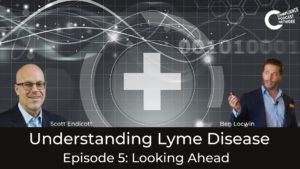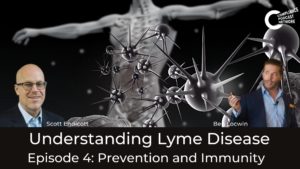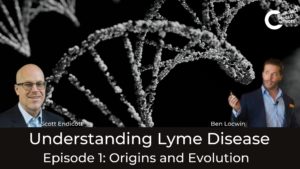Scott Endicott and Ben Locwin with host Tom Fox are back for this concluding capstone episode in the Understanding Lyme Disease Podcast series. In this episode, they talk about the most current developments in Lyme Disease treatment, what’s new in diagnostic treatments and what is on the horizon for both treatments and Lyme Disease patients.
Resources
Scott Endicott | LinkedIn
Ben Locwin | LinkedIn | Twitter
American Lyme Disease Foundation www.aldf.com
LymeDisease.org
International Lyme and Associated Diseases Educational Foundation ILADEF
International Lyme and Associated Diseases Society
Tag: Lyme Disease

Scott Endicott and Ben Locwin with host Tom Fox are back for part 5 of the Understanding Lyme Disease Podcast series. In this episode, they talk about living with chronic toxicity and co-infectious agents.
A Useful Approach to Knowledge
The best way to help yourself, and loved ones who have been diagnosed with Lyme disease, is to seek out accurate information to make sure that you get the best treatment options available. The earlier treatment is applied, the more effective it is.
The Next Steps
Scott talks about a few innovative initiatives regarding Lyme disease. Focusing on diagnostic criteria and treatment approaches will be a great opportunity to turn the disease around. Currently, there is an increased acceptance of the disease and less stigma so that will go a long way in creating more options and opportunities for treatment. “There’s been a much broader acceptance of Lyme in health insurance claims that’s actually gone from being a very difficult diagnosis to one that’s much more accepted,” Scott tells Tom. On the chronic side of the disease, Scott recommends that persons afflicted with tick bites get doxycycline in their systems as soon as possible.
Knowing The Cause
The more patients understand about Lyme disease, the more they would be able to apply smarter resources to improve prevention and care. They can be able to manipulate the neutrophils [the disruption of the immune system]. The more they understand about the science behind the causative agents, the easier it will be to fight it.
Resources
Scott Endicott | LinkedIn
Ben Locwin | LinkedIn | Twitter

Scott Endicott and Ben Locwin with host Tom Fox are back for part 4 of the Understanding Lyme Disease Podcast series. In this episode, they talk about the immune system as the body’s first line of defense, how to boost your immunity, and take charge of your health.
Prevention Beats Correction
Prevention beats correction every time, and the best way to treat Lyme disease is to reduce your chances of contracting it at all. Ben advises listeners to take precautions when entering areas where ticks are common. Wear long-sleeved shirts, long pants, and boots if possible. Use tick repellent, salves, and sprays. If you do happen to find a tick on you, only remove it with tweezers; do not use petroleum jelly or try to burn it off.
Post Treatment Lyme Disease Syndrome
Some patients who have been treated for Lyme disease still feel lingering symptoms. This used to be considered Chronic Lyme Disease. Evidence shows that no persistent infection is left within patients so the official term is now Post Treatment Lyme Disease Syndrome.
Building Your Immunity
One of the best things a person can do is work on building their self immunity. Improving your diet, exercise, and stress levels are key to your recovery. A consistent exercise regimen especially helps to build back your immunity. “Many of the side effects and symptoms of persistent Lyme or Post Treatment Lyme Disease are psychiatric and mental,” Scott tells Tom. Doing your best to fortify your body and mind is going to do wonders with strengthening your immune system.
Take Charge of Your Health
You need to take charge of your health, both physically and mentally. “Being discerning about your own health and being your own advocate is probably one of your best defenses,” Scott says. Do what you can to ease stress: yoga or meditation are good options. Make use of the information that is available; get educated about what’s happening around you so you can make decisions about your own medical care.
Resources
Scott Endicott | LinkedIn
Ben Locwin | LinkedIn | Twitter

Tom Fox welcomes back Scott Endicott and Ben Locwin to part 3 of the Understanding Lyme Disease Podcast Series. In this episode, they look at treatment solutions for Lyme disease.
The Current Lyme Treatment
The current treatment for Lyme disease is more focused on adults. It’s a non innovative approach, however, as Ben points out. The current standard treatment is a 100 milligram dosage of Doxycycline twice per day for 10 to 12 days. Patients will typically get three weeks worth of prescription. For children, they are prescribed Amoxicillin as they can’t tolerate Doxycycline. This dosage would be 50 milligrams, three times a day. The current treatment protocols are inadequate for the population who have Lyme disease symptoms, Ben tells Tom. Both the infectious disease community and the academic research and physician community are holding fast to their own views on how Lyme disease is to be treated and what works and what doesn’t. This poses a challenge, Scott remarks.
The Need For Innovation
“The Health and Human Services (HHS) just put together a working group that is actually looking at emergent innovative approaches, and some of those innovative approaches are ones that the Lyme specialists have been using for many years, like PICC lyme antibiotics, essentially intravenous antibiotics in order to arrest very accelerated symptoms and symptoms that have taken patients to a place where there needs to be massive changes to their health or things are going to continue… to just get worse,” he adds. This kind of innovation needs to be more normalized, and clinical experts need to remove themselves from their old school way of thinking. When new data is coming in from patient case reports, experts should be able to build new hypotheses, Scott and Ben argue. They shouldn’t have such an emotional conviction to past beliefs that they can’t be moved by new data. Innovating patient care and treatment is to understand exactly what is clear within the data, and for what isn’t clear, to make adjustments.
The Next Step
Research and medication needs to adapt. What was believed to be effective in the past is no longer so in the present. “Frankly in clinical medicine, the endpoints to show that something is efficacious are either to demonstrate improvements and how a patient feels or functions or survives,” Scott says. Measuring survivability is important but if patients are presenting that they don’t feel well, or aren’t functioning the same, and medical experts turn a blind eye to that, then there will be no innovation in terms of truly tackling the disease. The next step for treatment would be diagnostic testing that gets much closer, and that which puts data back into the hands of clinicians, so they can advise patients properly and with better protocols.
Resources
Scott Endicott | LinkedIn
Ben Locwin | LinkedIn | Twitter

Scott Endicott and Ben Locwin are Tom Fox’s guests on the first episode of the Lyme disease series. Scott is the Executive Leader of Healthcare Solutions at CliniHealth Solutions. Ben is a TEDx speaker, healthcare and pharmaceutical executive with experience in senior management teams. They join Tom to talk about how Lyme disease first came about, symptoms, and the misinformation surrounding the disease.
The Discovery of Lyme Disease
Lyme disease has been around for millions of years, however, it evaded detection until the 1960s. The first diagnosed cases were occurring around Old Lyme, Connecticut which is how the disease got its name. It was first detected within children who had pediatric rheumatoid arthritis symptoms. A man named Willy Burgdorfer, who was a researcher, was trying to find the cause of the symptoms. He had been looking at spotted fever as well as other tick-borne diseases at the time and turned his attention to Old Lyme, Connecticut. In 1981 he found an organism within the affected children, and so the organism itself is named Borrelia Burgdorferi after him.
The First Diagnosis
There has been a lot of confusion regarding the symptoms related to Lyme disease, so it is important to know what the true symptoms of the disease are and what to look out for. “The diagnostic criteria has been a moving target since 1975,” Scott begins. The original Lyme disease epidemic was juvenile arthritis, and that was the trigger that pushed the community at the time to do further investigation as arthritis is not contagious. That confusion set the tone on how the disease was first diagnosed.
The Evolution of Lyme Research
Lyme has been detected in all US states of America except Hawaii. At one point it was believed that germs in the air was the cause for the disease going around. This was called germ theory. Today, the research and science has evolved, and information exchange and diagnostic criteria are becoming aligned. Nowadays, Lyme disease can be treated with simple antibiotics with very high efficacy. This is because there are more clinical professionals who are able to identify the disease early, and treat it effectively.
Resources
Scott Endicott | LinkedIn
Ben Locwin | LinkedIn | Twitter


